As we described in a previous article, the Global Cannabis Stock Index added to its 17.1% rally in October during November, increasing 3.7%. The index is still down 58.4% in 2022.
In this exclusive article we will summarize the performance of the other managed indices that New Cannabis Ventures offers to its readers. We will discuss the performance of the American Cannabis Operator Index, Ancillary Cannabis Index and Canadian Cannabis LP Index as well as Canadian Cannabis LP index Tier 1, 2 and 3.
American Cannabis Stocks Index
The American Cannabis Operator Index fell 30.0% in September and then rose 33.9% in October. In November, it dipped 1.9% despite the rally in cannabis stocks, falling to 24.06:
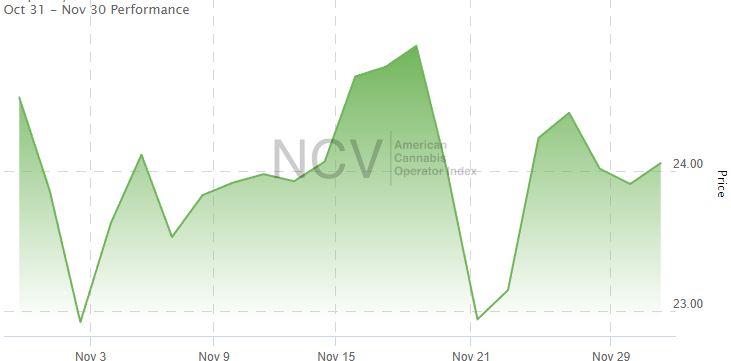
Down 11.3% in Q3, the index, after the large rally in October and pullback in November, is down 42.3% year-to-date, well ahead of the Global Cannabis Stock Index:
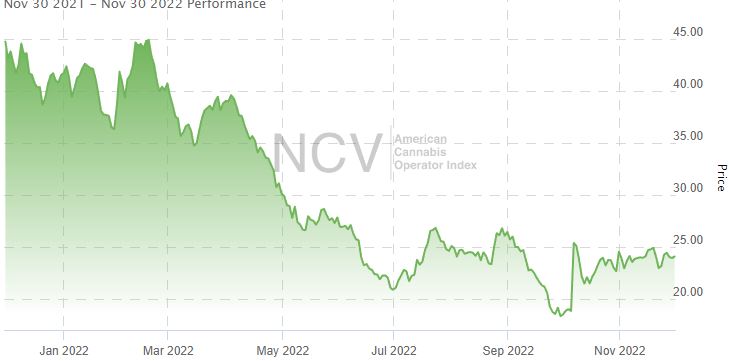
The index, which launched in October 2018, never took out the low from March 2020:
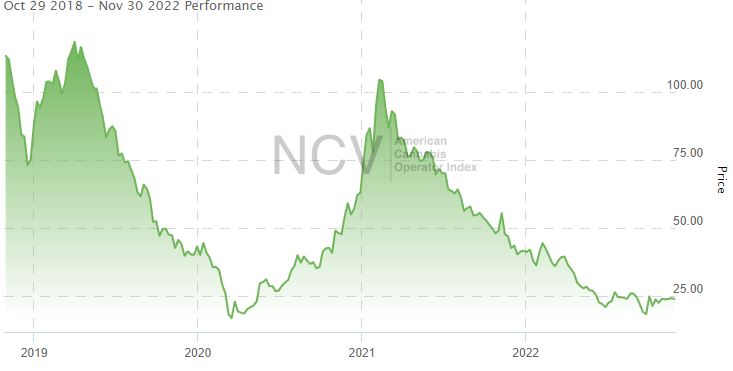
During November, the strongest names all rallied more than 10% and included Curaleaf (OTC: CURLF) (CSE: CURA), Jushi Holdings (OTC: JUSHF) (CSE: JUSH), TerrAscend (OTC: TRSSF) (CSE: TER) and Trulieve (OTC: TCNNF) (CSE: TRUL). Three stocks fell more than 20%: Ayr Wellness (OTC: AYRWF) (CSE: AYR.A), Upexi (NASDAQ: UPXI) and Charlotte’s Web (OTC: CWBHF) (TSX: CWEB).
Ancillary Cannabis Index
The Ancillary Cannabis Index has captured a terrible sector in 2022. It plunged 27.1% in September to an all-time closing low of 17.80 and rallied 5.6% in October to 18.80. In November, it extended the rally, gaining 6.7% to 20.06:
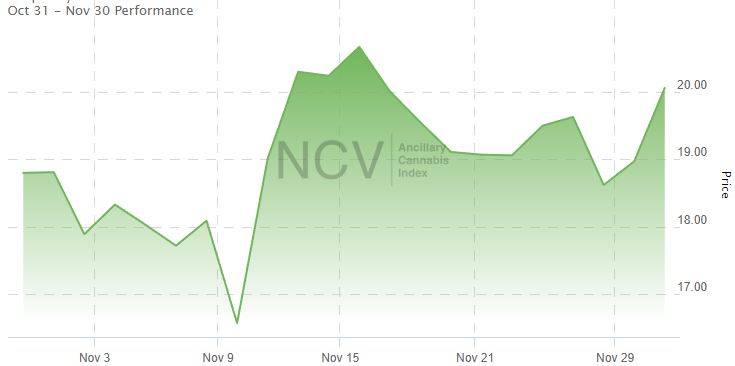
Even with the gain, the index is down 68.8% in 2022:
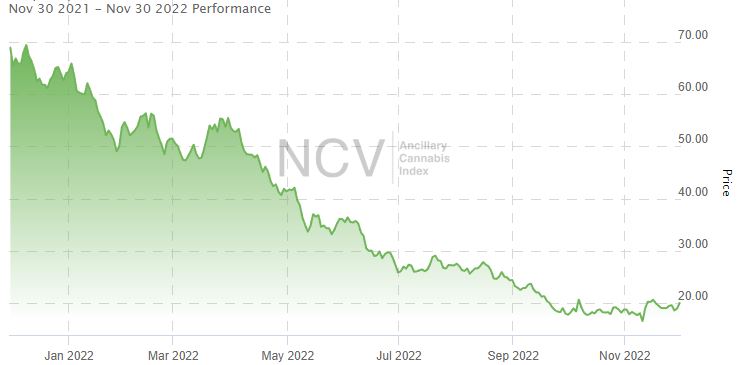
The index is down almost 80% since launching at the end of March in 2021:
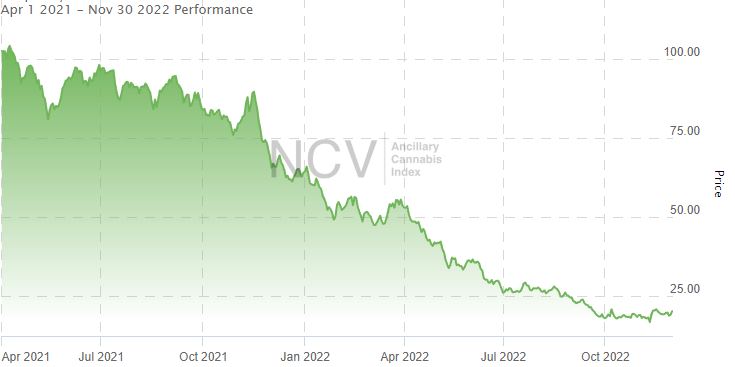
During November, the best performing stocks, both up more than 50%, were GrowGeneration (NASDAQ: GRWG) and SHF Holdings (NASDAQ: SHFS). The largest decliners, both falling more than 38%, were WM Technology (NASDAQ: MAPS) and Agrify (NASDAQ: AGFY).
Canadian Cannabis LP Index
The Canadian Cannabis LP Index gave up a lot of ground in November, falling 7.5% to 89.80:
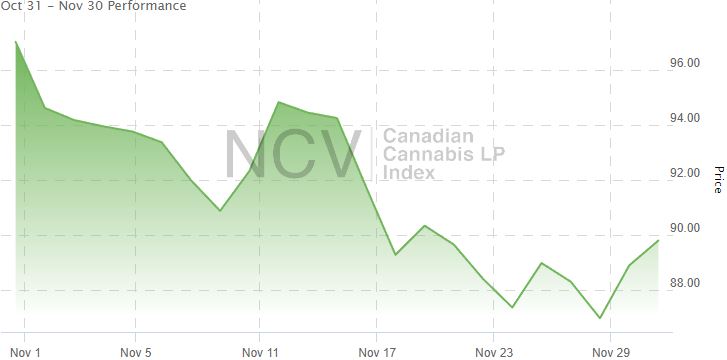
The index has declined 53.9% in 2022 from its year-end 2021 close of 194.95:

It remains above its early-day lows, but it is down a lot from the peak:
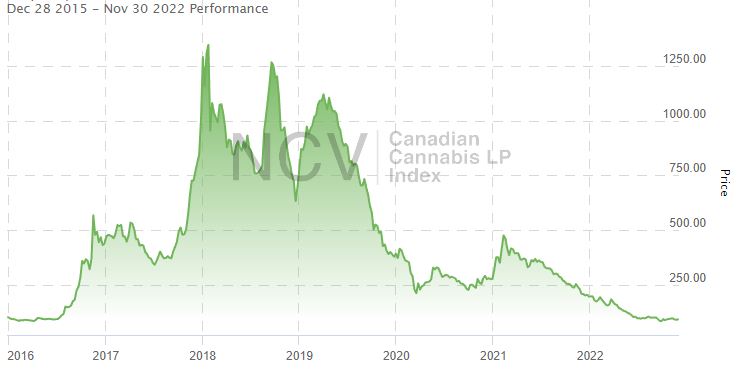
Canadian Cannabis LP Tier 1 Index
Tier 1 index soared 16.9% in August, sank 18.8% in September and rallied 24.6% in October to 144.26. During November, it dropped 8.1% to 132.64. Tier 1, which is now down 57.8% in 2022, dropped 17.7% in 2021 when it ended at 314.28. Among Tier 1 companies, Organigram (TSX: OGI) (NASDAQ: OGI), unchanged, was the best performer, while HEXO Corp. (TSX: HEXO) (NASDAQ: HEXO) was the worst performer again, falling 17.0%.
Canadian Cannabis LP Tier 2 Index
Tier 2 index plunged 18.5% in September and recovered with an 8.0% rally in October to 128.42. During November, it advanced by 0.3% to 128.79. In 2021, it lost 17.1%, closing at 267.36, and it is now down 51.8% in 2022. Among Tier 2 companies, the worst stock was Auxly Cannabis Group (TSX: XLY) (OTC: CBWTF) again, which fell 44.4%, while the best performing stock was Aleafia Health (TSX: AH) (OTC: ALEAF), which gained 36.4%.
Canadian Cannabis LP Tier 3 Index
Tier 3 index dropped 18.3% in September and then rallied 23.2% in October. In November, it plunged 14.1% to 21.08. It ended at 47.42 in 2021, declining 19.9%, and is now down 55.6% in 2022. Among Tier 3 companies, four stocks lost more than 25% of their value: IM Cannabis (CSE: IMCC) (NASDAQ: IMCC), The Green Organic Dutchman (CSE: TGOD) (OTC: TGODF), Lifeist Wellness (TSX: LFST) (OTC: NXTTF) and Delta 9 Cannabis (TSXV: DN) (OTC: DLTNF).
New Cannabis Ventures maintains seven proprietary indices designed to help investors monitor the publicly-traded cannabis stocks, including the Global Cannabis Stock Index as well as the Canadian Cannabis LP Index and its three sub-indices. The sixth index, the American Cannabis Operator Index, was launched at the end of October 2018 and tracks the leading cultivators, processors and retailers of cannabis in the United States. Afterwards, we introduced the Ancillary Cannabis Index at the end of March 2021, reflecting the increasing number of publicly-traded companies providing goods or services to cannabis operators.
